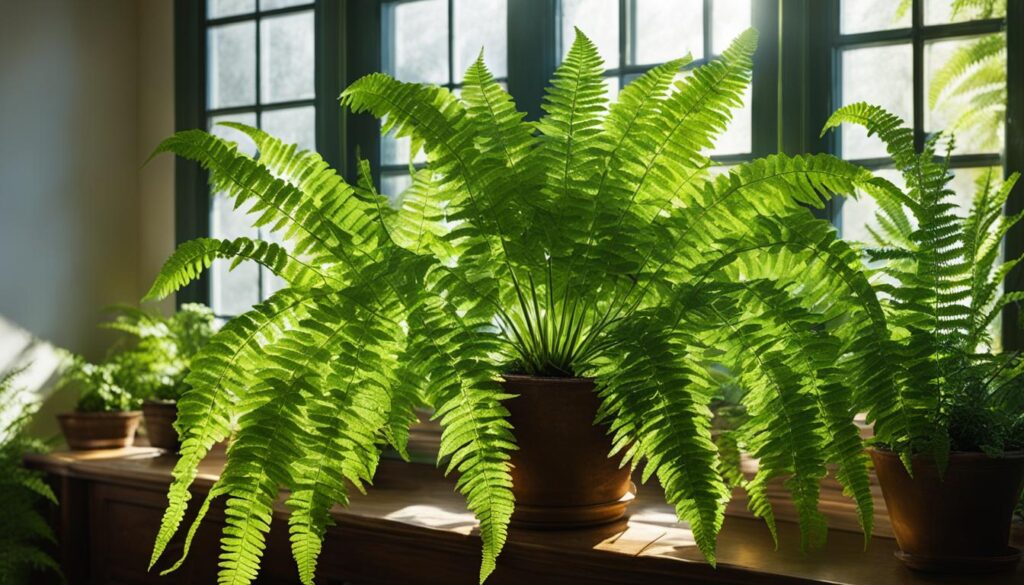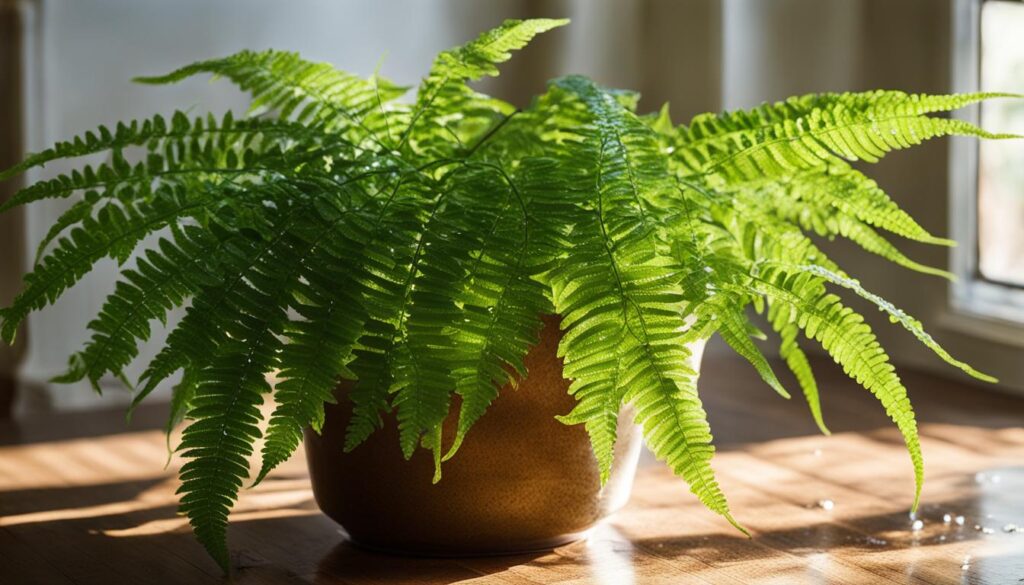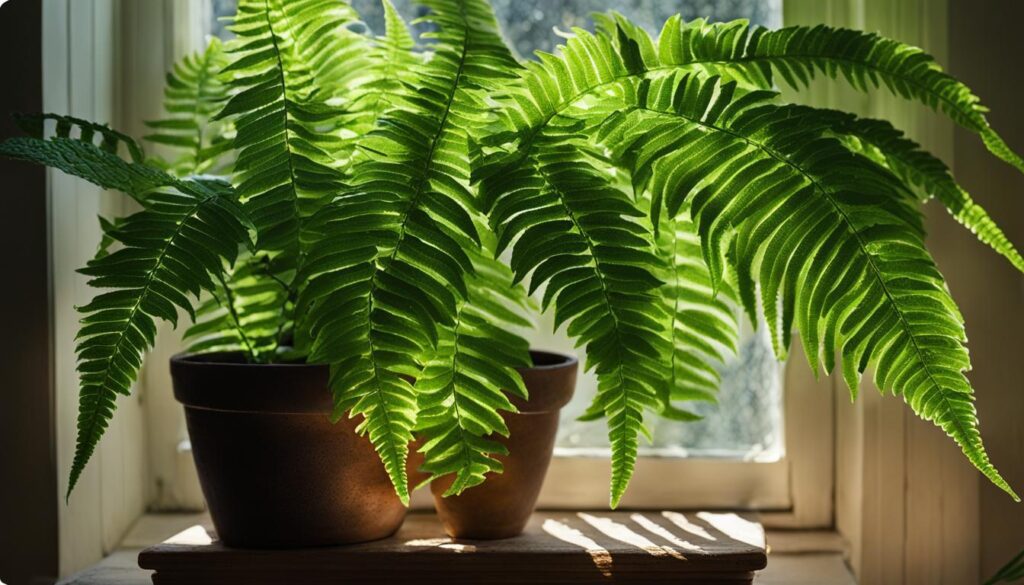Are you wondering if Boston ferns can thrive in full sun? Understanding the needs of these beautiful plants is essential for their care and growth. Boston ferns are known for their adaptability and can flourish in medium to bright, indirect sunlight. However, prolonged exposure to bright direct sunlight can actually harm them, causing their leaves to burn and scorch.
Creating the right environment for your Boston ferns involves more than just sunlight. These plants prefer temperatures ranging from 18º-25ºC and thrive in humid environments. Proper watering is crucial, with weekly sessions to keep their soil moist but not wet. Adding a general houseplant fertilizer monthly during the growing season can also promote healthy growth.
If you have small children or pets at home, you’ll be relieved to know that Boston ferns are non-toxic and safe to have around. However, it’s important to pay attention to any browning or drying fronds, as this may indicate underwatering, exposure to dry air, or direct sunlight.
With the right care, your Boston ferns can thrive in your garden or as houseplants, adding beauty and greenery to your living space.
Key Takeaways:
- Boston ferns prefer medium to bright, indirect sunlight and should avoid prolonged exposure to direct sunlight.
- Maintain temperatures between 18º-25ºC and provide a humid environment for optimal growth.
- Water your Boston ferns weekly, keeping the soil moist but not wet.
- During the growing season, fertilize your ferns with a general houseplant fertilizer once a month.
- Watch out for browning or drying fronds, as this may indicate a lack of water, dry air, or direct sunlight.
Light Requirements for Boston Ferns
Boston ferns have specific light requirements that vary depending on the time of year. Understanding their lighting needs is essential to ensure their health and vitality. In this section, we will explore the optimal lighting conditions for Boston ferns and provide you with practical tips to meet their needs.
Fall and Winter: Bright, Indirect Light
During the fall and winter months, Boston ferns benefit from bright, indirect light. Place your fern in a location where it can receive at least two hours of indirect sunlight per day. This can be achieved by positioning it near a window with filtered light or by using sheer curtains to diffuse the sunlight. Avoid exposing your Boston fern to direct, intense sunlight as it can scorch and damage the delicate fronds.
Spring and Summer: Semi-Shady Location
As spring and summer bring more intense sunlight, it’s important to adjust the placement of your Boston fern. During these seasons, the fern requires a semi-shady location to protect it from the harsh rays of the sun. Consider placing it near a window with a northern exposure, where it can receive bright, indirect light without being exposed to direct sunlight. This gentle balance of light will help your fern thrive and maintain its vibrant green foliage.
Preventing Leaf Drop
Proper lighting is crucial for Boston ferns, as inadequate sunlight can cause them to drop their leaves. If your fern isn’t receiving enough light, you may notice a gradual yellowing and shedding of fronds. In such cases, reposition the plant to a spot with better lighting conditions or consider supplementing with artificial light sources, such as fluorescent bulbs.
The following table summarizes the light requirements for Boston ferns:
| Season | Light Requirement |
|---|---|
| Fall and Winter | Bright, indirect light (at least 2 hours of indirect sunlight per day) |
| Spring and Summer | Semi-shady location (protected from direct, intense sunlight) |
By providing your Boston fern with the right amount and quality of light throughout the year, you can create an optimal environment for its growth and enjoy the beauty of this timeless houseplant.
Watering and Humidity for Boston Ferns
Boston Ferns require consistent moisture to thrive. Proper watering techniques and managing humidity levels are essential to their health and well-being. Here are some guidelines to help you ensure your Boston Ferns have the appropriate watering and humidity conditions:
Watering:
It’s important to keep the soil of your Boston Fern moist but not wet. To achieve this, water your fern thoroughly once a week, allowing the water to drain freely from the bottom of the pot. Before watering again, make sure the top 2 inches of soil have dried out. This will help prevent overwatering, which can lead to root rot.
During the winter months, when Boston Ferns are in their dormant phase, you can reduce watering frequency. Allow the top 2 inches of soil to dry out before watering, but still maintain a slightly moist environment. Be mindful of the drying effects of indoor heating systems, and adjust your watering schedule accordingly.
Humidity:
Boston Ferns thrive in humid environments. They naturally grow in the understory of tropical forests, where humidity levels are high. To replicate these conditions, you can mist your fern regularly with room-temperature water. This will help increase humidity around the plant. Alternatively, you can create a pebble tray by filling a shallow dish with water and placing the pot on top of it. As the water evaporates, it will create a humid microclimate around the fern.
If you have a bathroom or kitchen with high humidity, these can be ideal locations for your Boston Fern. The steam from showers or cooking will provide the moisture your fern craves. Just make sure to place the fern where it receives adequate indirect light.
Summary:
To keep your Boston Ferns healthy, provide them with consistent moisture and appropriate humidity levels. Water thoroughly once a week, allowing the top 2 inches of soil to dry out between waterings. Mist the fern regularly or place it in a humid environment such as a bathroom or kitchen. By following these guidelines, your Boston Ferns will thrive and add beauty to your indoor or outdoor space.
Temperature and Fertilizer for Boston Ferns
Proper temperature and fertilizer are key factors in the care of Boston Ferns. These plants prefer temperatures ranging from 18º-25ºC, making them well-suited for indoor environments. However, they can tolerate slightly colder or warmer spaces as long as they are shielded from cold drafts and abrupt temperature changes. It’s important to keep your Boston Fern away from air conditioning vents, radiators, or windows with a strong draft.
During the growing season, which typically spans from spring to summer, Boston Ferns benefit from regular fertilization. You can use a general houseplant fertilizer to provide the necessary nutrients for healthy growth. However, it’s essential to follow the instructions on the fertilizer package to avoid over-fertilizing, as this can lead to browning and drying of the fronds. Monthly fertilization during the growing season should be sufficient to support the fern’s growth and vitality.
Boston Ferns are versatile plants that can adapt to various conditions, but temperature and fertilizer play crucial roles in their overall well-being. By providing the optimal temperature range and feeding them regularly during the growing season, you can ensure that your Boston Fern thrives and remains a beautiful addition to your indoor or outdoor space.
Can Boston Ferns Be Placed in Areas with Minimal Bee Attraction?
Yes, Boston ferns are great potted plants for bee control in areas with minimal bee attraction. The dense foliage and lack of bright, colorful flowers make them less appealing to bees. This makes them a good choice for those looking to avoid attracting bees to their living spaces.
Conclusion
In conclusion, Boston ferns are versatile and adaptable plants that do not thrive in full sun. They prefer medium to bright, indirect sunlight, as prolonged exposure to bright direct sunlight can lead to leaf burn and scorching. It is important to find a location for your Boston fern where it can receive at least two hours of indirect sunlight per day during fall and winter, and a semi-shady spot with a northern exposure during spring and summer.
Proper watering and humidity are key to the health of Boston ferns. Weekly watering sessions are recommended, ensuring that the soil remains moist but not wet. Allowing the top 2 inches of soil to dry out between waterings during winter is also important. Boston ferns appreciate a humid environment and can benefit from misting or being placed near other plants. Consider creating a pebble tray with water to increase humidity levels.
In terms of temperature, Boston ferns prefer a range of 18º-25ºC, but they can tolerate slightly colder or warmer conditions as long as they are protected from cold drafts and sudden temperature changes. During the growing season (spring to summer), monthly fertilization with general houseplant fertilizer is recommended, although over-fertilizing should be avoided to prevent frond browning and drying.
By following these care guidelines, your Boston fern can thrive both as a garden plant and as a houseplant, even without full sun exposure. Take care to provide the right light conditions, maintain proper watering and humidity, and ensure suitable temperature and fertilization. With these considerations in mind, you can enjoy the beauty and lushness of your Boston fern for years to come.
FAQ
Do Boston Ferns like full sun?
No, Boston Ferns do not like full sun. They prefer medium to bright, indirect sunlight.
What are the light requirements for Boston Ferns?
Boston Ferns thrive in medium and bright, indirect sunlight. Prolonged exposure to bright direct sunlight may burn and scorch their leaves.
How often should I water my Boston Fern and what humidity levels do they prefer?
Boston Ferns enjoy weekly watering sessions, keeping their soil moist but not wet. They appreciate a humid environment and can be misted frequently or placed close to other plants. Creating a pebble tray partly filled with water can also increase humidity. Boston Ferns thrive in steamy bathrooms and kitchens.
What are the ideal temperature and fertilizer requirements for Boston Ferns?
Boston Ferns prefer temperatures ranging from 18º-25ºC and can tolerate colder or warmer spaces if kept away from cold drafts and abrupt temperature changes. During the growing season (spring to summer), they can be fed with general houseplant fertilizer monthly.
What is the conclusion regarding Boston Fern care and full sun exposure?
Boston Ferns do not like full sun and prefer medium to bright, indirect sunlight. They thrive in a humid environment and require weekly watering to keep their soil moist. Proper temperature, fertilizer, and avoiding direct sunlight are essential for their health. With these care guidelines, your Boston Fern can thrive in your garden or as a houseplant, even without full sun exposure.











